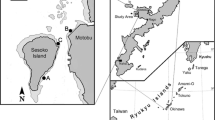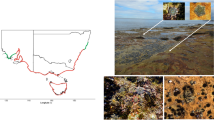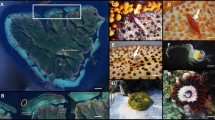Abstract
Pelagic Sargassum spp. is important in the life histories of many economically and ecologically important associated organisms, which collectively form a symbiotic community with this alga serving as the primary host. Fishes play a vital role in these communities, but it is generally unknown how they locate these floating symbiotic habitats. This study examined the role of natural chemical cues from Sargassum spp. patches and a synthetic chemical dimethylsulfoniopropionate (DMSP) for an associated fish, the planehead filefish (Stephanolepis hispidus), and a control fish species not associated with Sargassum spp., the masked goby (Coryphopterus personatus). Choice trials with a Y-maze (olfactometer) apparatus determined that S. hispidus responded significantly to chemical cues from Sargassum spp. while C. personatus did not. DMSP cues did not result in significant behavioral responses for either fish species. Demonstrating that S. hispidus can respond to chemical cues from Sargassum spp. helps further our understanding of this unique floating algal reef and how fishes might locate it to establish this subcomponent of the holobiont (the collective symbionts in the association).


Similar content being viewed by others
References
Barnes B, Yuyuan X, Hu C (2023) Outlook of 2023 Sargassum blooms in the Caribbean Sea and Gulf of Mexico. https://optics.marine.usf.edu/projects/saws.html
Berry FH, Vogele LE (1961) Filefishes (Monocanthidae) of the western North Atlantic. Fish Bull U S Fish Wildl Serv U S 61:61–109
Bortone SA, Hastings PA, Collard SB (1977) The pelagic Sargassum ichthyofauna of the eastern gulf of Mexico. Northeast Gulf Sci 1:60–67
Brooks WR, Hutchinson KA, Tolbert MG (2007) Pelagic Sargassum mediates predation among symbiotic fishes and shrimps. Gulf of Mex Sci 2:141–152
Butler JN, Morris BF, Cadwallader J, Stoner AW (1983) Studies of Sargassum and the Sargassum Community. Bermuda Biological Station Special Publ No. 22. pp. 307
Carr A (1987) New perspectives on the pelagic stage of sea turtle development. Conserv Biol 1:103–121
Casazza TL, Ross SW (2008) Fishes associated with pelagic Sargassum and open water lacking Sargassum in the Gulf Stream off North Carolina. Fish Bull 106:348–363
Coston-Clements LR, Settle DE, Hoss (1991) and F. A. C. Utilization of the Sargassum habitat by marine invertebrates and vertebrates – A. Review
Dacey JWH, Wakeham SG (1986) Oceanic dimethylsulfide: production during zooplankton grazing on phytoplankton. Science 233:1314–1316
DeBose JL, Lema SC, Nevitt GA (2008) Dimethylsulfoniopropionate as a foraging cue for reef fishes. Science 319(5868):1356
Debose JL, Nevitt GA, Dittman AH (2010) Rapid communication: experimental evidence that juvenile pelagic jacks (Carangidae) respond behaviorally to DMSP. J Chem Ecol 36(3):326–328
Derby CD, Sorensen PW (2008) Neural processing, perception, and behavioral responses to natural chemical stimuli by fish and crustaceans. J Chem Ecol 34(7):898–914
Dooley JK (1972) Fishes associated with the pelagic Sargassum complex, with a discussion on the Sargassum community. Contrib Mar Sci 16:1–32
Fedoryako BI (1989) A comparative characteristic of the oceanic fish assemblage associated with floating debris. J Icthyology 29:128–137
Frahm JL, Brooks WR (2021) The use of chemical cues by Sargassum Shrimps Latreutes fucorum and Leander tenuicornis in establishing and maintaining a symbiosis with the host Sargassum algae. Diversity 13:305. https://doi.org/10.3390/d13070305
Hay ME (1996) Marine chemical ecology: what’s known and what’s next? J Exp Mar Biol Ecol 200:103–134
Hill RW, Dacey JWH (2006) Metabolism of dimethylsulfoniopropionate (DMSP) by juvenile Atlantic menhaden (Brevoortia tyrannus). Mar Ecol Prog Ser 322:239–248
Hunter JR, Mitchell CT (1968) Field experiments on the attraction of pelagic fish to floating objects. J Cons Int Explor Mer 31:427–434
Ingólfsson A (1998) Dynamics of macrofaunal communities of floating seaweed clumps off western Iceland: a study of patches on the surface of the sea. J Exp Mar Biol Ecol 231:119–137
Jobe CF, Brooks WR (2009) Habitat selection and host location by symbiotic shrimps associated with Sargassum communities: the role of chemical and visual cues. Symbiosis 49:77–85
Johnson BR, Atema J (1986) Chemical stimulants for a component of feeding behavior in the common gulf-weed shrimp Leander tenuicornis (say). Biol Bull 170:1–10
Kingsford MJ (1995) Drift algae: a contribution to near-shore habitat complexity in the pelagic environment and an attractant for fish. Mar Ecol Prog Ser 116:297–301
Kowalewsky S, Dambach M, Mauck B, Dehnhardt G (2006) High olfactory sensitivity for dimethyl sulphide in harbour seals. Biol Lett 2(1):106–109
Lapointe BE (1986) Phosphorus-limited photosynthesis and growth of Sargassum natans and Sargassum fluitans (Phaeophyceae) in the western North Atlantic. Deep-Sea Res 33:391–399
Lapointe BE (1995) A comparison of nutrient-limited productivity in Sargassum natans from neritic vs. oceanic waters of the western North Atlantic Ocean. Limnol Oceanogr 4:625–633
Lapointe BE, West LE, Sutton TT, Hu C (2014) Ryther revisited: nutrient excretions by fishes enhance productivity of pelagic Sargassum in the western North Atlantic Ocean. J Exper Mar Biol Ecol 458:45–56
Lecchini D, Osenberg CW, Shima JS, St Mary CM, Galzin R (2007) Ontogenetic changes in habitat selection during settlement in a coral reef fish: ecological determinants and sensory mechanisms. Coral Reefs 26(2):423–432
Lenanton RCJ, Caputi N (1989) The roles of food supply and shelter in the relationship between fishes, in particular Cnidoglanis macrocephalus (Valenciennes), and detached macrophytes in the surf zone of sandy beaches. J Exp Mar Biol Ecol 128:165–176
Lenanton RCJ, Robertson AI, Hansen JA (1982) Nearshore accumulations of detached macrophytes as nursery areas for fish. Mar Ecol Prog Ser 9:51–57
Mancera-Rodriguez NJ, Castro-Hernandez JJ (2015) Reproductive biology of the planehead filefish Stephanolepis hispidus (Pisces: Monocanthidae), in the Canary Islands area. Ichthyol Res 62:258–267
Mansfield KL, Wyneken J, Luo J (2021) First Atlantic satellite tracks of ‘lost years’ green turtles support the importance of the Sargasso Sea as a sea turtle nursery. Proc R Soc B 288:20210057. https://doi.org/10.1098/rspb.2021.0057
Manzella S, Williams J (1991) Juvenile head-started Kemp’s ridleys found in floating grass mats. Mar Turt Newsl 52:5–6
Martin RA (2007) A review of behavioural ecology of whale sharks (Rhincodon typus). Fish Res 84:10–16
Nevitt GA, Veit RR, Karieva P (1995) Dimethyl sulfide as a foraging cue for Antarctic procelariiform seabirds. Nature. 376(6542): 680–682. NOAA. 1996. Magnuson-Stevens Fishery Conservation and Management Act, as amended through Oct. 11, 1996. NOAA Tech. Mem. NMFS-F/SPO-23. 121 p
Rudershausen PJ, Buckel JA, Edwards J, Gannon DP, Butler CM, Averett TW (2010) Feeding ecology of blue marlins, dolphinfish, yellowfin tuna, and wahoos from the North Atlantic Ocean and comparisons with other oceans. Trans Am Fish Soc 139:1335–1359
Ryther JH (1956) The Sargasso Sea. Sci Am 194:98–104
Stachowicz JJ, Lindquist N (1997) Chemical defense among hydroids on pelagic Sargassum: predator detternce and absorption of solar UV radiation by secondary metabolites. Mar Ecol Prog Ser 155:115–126
Stoner AW (1983) Pelagic sargassum: evidence for a major decrease in biomass. Deep Sea Res 30:469–474
Turner JP, Rooker JR (2006) Fatty acid composition of flora and fauna associated with Sargassum mats in the Gulf of Mexico. Mar Biol 149(5):1025–1036
Vila-Costa M, Rinta-Kanto JM, Poretsky RS, Sun S, Kiene RP, Moran MA (2014) Microbial controls on DMSP degradation and DMS formation in the Sargasso Sea. Biogeochemistry 120(1–3):295–305
Wells DRJ, Rooker JR (2004) Spatial and temporal patterns of habitat use by fishes associated with Sargassum mats in the northwestern gulf of Mexico. Bull Mar Sci 74:81–99
Witherington B, Hirama S, Hardy R (2012) Young sea turtles of the pelagic Sargassum-dominated drift community: habitat use, population density, and threats. Mar Ecol Prog Ser 463:1–22
Wong K, Cheung PC (2001) Influence of drying treatment on three Sargassum species. J Appl Phycol 13:51–58
Zilber-Rosenberg I, Rosenberg E (2008) Role of microorganisms in the evolution of animals and plants: the hologenome theory of evolution. FEMS Microbiol Rev 32:723–735
Acknowledgements
Thanks to John Baldwin and Brian Lapointe for their helpful comments and suggestions throughout the completion of this project. Special thanks to Chelsea Bennice and Lorin West for their unending support ranging from field work to fish husbandry. This published work was derived from an MS Thesis project completed by the first author (Cox).
Author information
Authors and Affiliations
Corresponding author
Ethics declarations
• The authors have no relevant financial or non-financial interests to disclose.
• No funding was received for conducting this study.
• All handling and experiments with fishes were approved by the Florida Atlantic University Institutional Animal Care and Use Committee (IACUC), established in accordance with the Animal Welfare Act and Public Health Service Policy on the Humane Care and Use of Animals.
Additional information
Publisher’s Note
Springer Nature remains neutral with regard to jurisdictional claims in published maps and institutional affiliations.
Rights and permissions
Springer Nature or its licensor (e.g. a society or other partner) holds exclusive rights to this article under a publishing agreement with the author(s) or other rightsholder(s); author self-archiving of the accepted manuscript version of this article is solely governed by the terms of such publishing agreement and applicable law.
About this article
Cite this article
Cox, D., Brooks, W.R. The role of chemical cues in locating the host pelagic Sargassum spp. by the symbiotic fish Stephanolepis hispidus. Symbiosis 90, 151–158 (2023). https://doi.org/10.1007/s13199-023-00924-w
Received:
Accepted:
Published:
Issue Date:
DOI: https://doi.org/10.1007/s13199-023-00924-w




